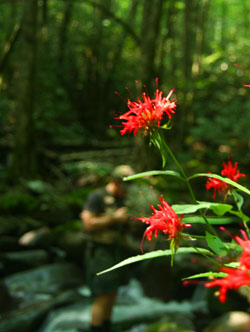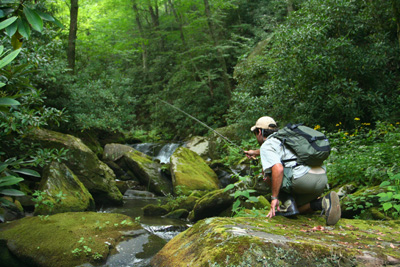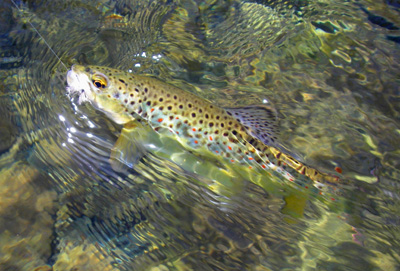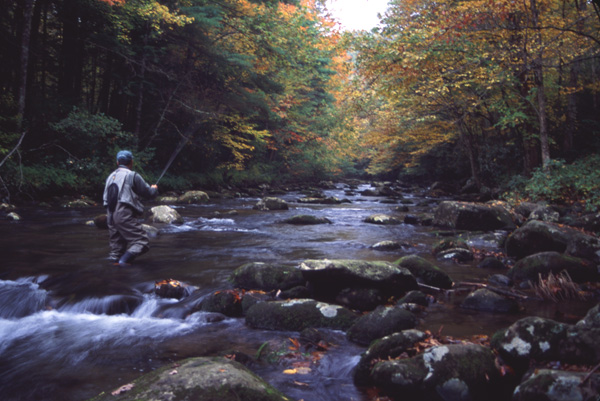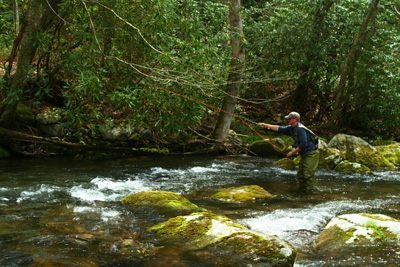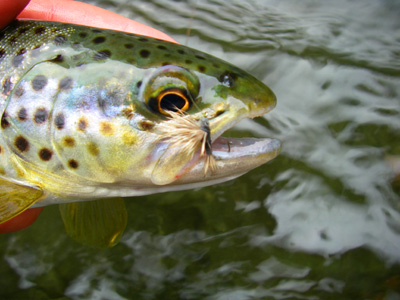This article first appeared in Fly Fishing & Tying Journal. The tips found in this article are especially critical to a fly fisher’s success catching trout in the Great Smoky Mountains of Tennessee and North Carolina. However, these methods will work on small streams anywhere.
Most fly fishermen feel like there is more to fishing than just catching fish. Beautiful surroundings, glimpses of wildlife, and privacy on the water often mean as much to a successful day on the water as eager fish. More and more fishermen are finding it hard to find all of those ingredients on large, popular rivers. Small streams might lack numbers of large trout but usually more than make up for that with greedy fish in a more private environment.
The number of small trout streams far outnumbers large rivers. It only makes sense since any river is composed of tributary streams. Most large trout rivers are fished much harder than more secluded small streams that are full of willing fish. However, many anglers fail to realize that they need to adjust their technique to take advantage of the opportunity. I often talk with fly fishermen visiting my home waters in the Great Smoky Mountains who have a tough time hooking fish. Many of these anglers aren’t familiar with small stream techniques and find that their big river tactics fall short. While fishing smaller waters is not particularly difficult, it is markedly different from big water. There are a number of things you can do to improve your success on small streams. These techniques can even improve your game on the big rivers like the Snake that have a number of small, braided channels or stretches of canyon pocket water.
1. Be sneaky
Small streams have less room for fish to move about in. The good news is that there are only so many places for the fish to go. The bad news is that the fish are far more sensitive to disturbance. Any trout that is aware of your presence is far less likely to eat than one that is carefree, going about his daily business of watching for food. The best presentation or the most innovative fly patterns will not hook fish that know what is going on. Move slowly and deliberately so you don’t slosh water while wading. Try to put your feet in gravel or sand as you wade. These spots provide stable footing. Large rocks will often be covered with slick algae that makes wading clumsy. In fact, stay out of the water whenever possible. Creeping along the bank is the quietest way to approach a good casting position. I’m always amazed at how many fishermen hit the stream in bright clothing. There are many times when a fish will follow your fly downstream. Just as he’s coming to eat the fly he will be looking in your direction. Subdued colors that blend into the background will mask your presence far better than bright colors.
2. Keep Moving
Most strikes will occur on the first or second cast to a particular lie. It’s not uncommon for fishermen to want to improve on a bad cast. However, if your first cast hit the water with a smack there is little chance that a fish will still be around to investigate a second offering. It’s better to move on to your next good opportunity rather than play a losing hand.
The same goes for good casts. If you’ve gotten several excellent drifts with no response, you need to move. Even if you’re getting strikes, move when the action starts to lull. Things have probably played out. By moving often you’ll put the fly over more fish. Putting the fly over more fish means finding more willing fish, which in turn adds up to more strikes.
3. Scale down to small stream sizes
Small streams are no place for 12-18′ leaders. Many casts might only be ten feet. Use a leader that allows you to cast short but still cast fly line. Seven and one half foot leaders will usually work well in small streams but don’t be afraid of going shorter. This is the arena for precise casts. A three foot error might not even hit the water so be sure you have enough fly line to make accurate casts.
Most fishermen will also mistake this to mean that a short rod is also required. This is not the case. It is relatively rare to find water where an eight foot fly rood is too large. My home waters of the Smokies have plenty of places where an eight foot rod is an inconvenience but there are more places where extra length helps mend line or make roll casts with precision. If you’re in a tight spot with a long rod you can always break it down and make the cast with the tip section. These are places where you’ll never play a trout on a reel. You might even fish with only half a rod in the smallest, tightest streams and keep your reel in your pocket.
4. Use tough terminal tackle
Streams with an abundance of overhanging tree limbs and roots protruding from banks can take a toll on your fly box. Most trout in these environs are naive and not at all leader shy so leave your 6X at home. You’re far more likely to get your fly back out of the branches with 3X or 4X. The few large fish you do hook in small streams will also have far more opportunities to break you off than their big river cousins. Heavy tippet will hold up to snags and abrasions better. By the same token, use flies that can stand up to some abuse. Small streams are places where a good fisherman can really rack up some numbers so use flies that can really take a beating. Many of the best fishermen in the Smokies gravitate toward wet flies only because they don’t constantly have to be dried out after catching a fish.
Even nice trout are rarely tippet shy in smaller, lesser fished waters
5. Assess the situation before you cast
One of the best things a small stream fisherman can do before lifting the rod is assess the situation. Will a roll cast be required because of obstructions to a back cast? Does the overhang near your target require a sidearm cast? Every pool, pocket, and run will be different and should be treated as such. This is really the element of small stream fishing that makes it so interesting. You should also identify how your drift will play out and make pre-emptive mends rather than try to mend a fly that is already dragging.
6. Prioritize the water
There are many situations where you can pat yourself on the back for catching a fish. But did you ever stop and think about whether or not you could have caught more than one fish? I’ll often see anglers shoot a cast to the head of the run and immediately get a strike. However, it may have been more effective to have made a short cast at the tail of the pool, then make a second cast to a good lie off to the side. Working your way up the run may give you shots at several fish while making one cast to the head might have gotten one fish but spooked all the rest.
Work your way upstream so you fish the water without spooking fish in the next location you plan to fish
7. Shorten your cast
This is one thing that anyone should be able to do. Most fishermen are striving to add yards to their cast. However, on small streams many anglers have a real knack for casting well beyond the target. There are a number of practical reasons for scaling down your cast. Tight quarters in small streams will snag your fly if you cast too much line. More importantly, a shorter cast keeps your line from crossing a number of conflicting currents. Long casts are prone to bad drifts in the broken water so common to small streams. Also, fly line hitting a trout on the head rarely gets a positive response.
This angler is nymphing a run only a few feet off his rod tip
8. Be sure not to ignore unlikely water
It’s easy to spot a prime pool and charge ahead to cast into it. Unfortunately, you’re likely to blow out some nice fish in your haste. It’s relatively common for large fish to reside in a rare large pool, but regularly feed just upstream or downstream of that location. I’ve stepped on more big fish than I care to remember by dismissing riffles or pockets on the fringes of a big pool. Plenty of fishermen unfamiliar with small streams might focus all of their attention on a few good size pools. Most of the trout caught in small streams will come out of pocket water so never ignore it.
9. Pick your fights
Fishing should be about fun and enjoying the outdoors. All too often I hear fly fishermen say that they stay away from small streams because they always get hung up. There are times when I’ll advise a novice client to skip a cast where he’s likely to get hung up. If hanging in brush is something that bothers you and just ruins your day, don’t feel obligated to cast under every difficult overhang. However, don’t get frustrated when you do hang up. Making the attempt might result in failure, but you’ll never progress if you don’t challenge yourself.
10. Don’t dwell on the fly pattern
It never fails. Have a good day on the water and everyone wants to know, “What’d you catch ’em on?” The more important question is, “What kind of water did you catch them in? Rough or smooth? Deep or shallow? Small stream fish are not particular about fly patterns. They may have fleeting moments of selectivity during a hatch but they will rarely look beyond a fly’s size and color. If you’re not getting any looks you should first evaluate how quiet you’ve been. Spooked trout have no reason to eat. If you’re reasonably sure that you have not spooked fish it’s a good idea to make a drastic change in your fly selection. Change from a dry fly to a nymph or small fly to a large fly. Small stream fish are usually willing takers so only big changes in your fly selection will make a big difference.
The time to make subtle pattern changes is after a series of hard looks and refusals. Fish have been drawn to the fly but something just didn’t pull the trigger. The best move is to go to a smaller size. Other changes in the pattern such as parachute style over Catskill ties are secondary considerations on these streams but may be important.
Even the best trout in a small stream are rarely particular about a fly. Bushy dry flies often work better than sparse, realistic patterns.
